Executive summary
Navigating the digital marketplace demands a keen understanding of customer feedback, a cornerstone for any business looking to thrive. This blog explores the art and science of capturing customer insights, spotlighting the critical role of customer feedback tools and strategies for engaging directly with your audience. Armed with techniques on how to collect customer feedback and the best practices for leveraging this goldmine of data, businesses can fine-tune their operations, products, and services to meet customer needs better.
Step into the shoes of your customers for a moment. What do you see? A landscape filled with choices, voices, and, most importantly, the opportunity to be heard. In this era where a single tweet can sway market trends, understanding and collecting customer feedback is essential. According to a revealing statistic, 93% of customers are more likely to return to businesses that excel in customer service. But how do you achieve this excellence without a direct line to the thoughts and feelings of those you serve?
Commencing on this quest for customer insights is just like assembling a puzzle. Each piece of feedback, whether a glowing review or constructive criticism, adds depth and clarity to the picture of your business through the eyes of those who matter most. This blog is your guide through the world of customer feedback, from the nuanced whispers of individual experiences to the collective roar of public opinion.
Here, we will explore the different types of feedback and arm you with practical, effective methods for gathering this invaluable input. With every insight collected, you are one step closer to crafting experiences that meet customer expectations. It ensures your compass always points towards true north in business success.
Related must-reads:
- How to measure customer satisfaction: Key metrics explained
- How to improve customer satisfaction in 2024?
- Mastering Customer Touchpoints to Elevate the Journey and Improve CX
- Voice of the Customer: Effective feedback methods
What is customer feedback?
Customer feedback is the lifeblood of business innovation and customer satisfaction. It is the direct line from your customers to your strategy meetings. Customer feedback reveals what they honestly think about your products, services, and overall experience. This feedback is way beyond just gathering opinions. Customer feedback is a compass that guides businesses toward fulfilling customer expectations. Whether it pours in through reviews, social media, surveys, or direct conversations, each piece of feedback is a valuable nugget of insight waiting to be mined.
Customer feedback is a collection of voices telling you what’s working, what’s failing, and how your business can improve. It is the praise that encourages your team to keep up the excellent work and the criticism that prompts a course correction. But it is not just about listening—it is about understanding. The challenge often lies in interpreting this feedback, especially when it is unstructured or indirect. Businesses must employ a mix of analytical tools and empathetic listening to decode the messages behind the words.
Understanding and acting on customer feedback is non-negotiable in today’s competitive landscape. It is what enables businesses to align their offerings with customer needs, tailor experiences that delight, and, ultimately, forge stronger connections with their audience. For businesses, integrating this feedback into operational and strategic decisions means they are not just aiming in the dark. Instead, they are making informed moves that resonate with their audience. This commitment to listening and evolving based on customer feedback is what sets thriving businesses apart from those that merely survive.
Why is collecting customer feedback important? And how is it used?
Understanding customer feedback is just like finding a guiding star in the competitive business landscape. It is much more than collecting comments or ratings. Customer feedback is about diving deep into your audience’s desires and experiences. This insight forms the bedrock for businesses to fine-tune their strategies, ensuring they resonate deeply with their customers.
Why gathering customer feedback is non-negotiable
- Reveals real customer needs: Feedback provides a clear window into your customers’ expectations. It uncovers specific insights beyond what sales data or trends can reveal.
- Identifies improvement areas: Feedback highlights where your product, service, or customer journey might falter. It offers direct pointers on where to focus enhancements.
- Enables personalization: Tailoring experiences based on customer feedback delights your audience and also fosters loyalty, setting your brand apart.
- Boosts satisfaction and loyalty: Acting on feedback can transform dissatisfied voices into loyal advocates. It elevates your brand’s reputation significantly.
- Inspires innovation: Insights from customers can spark new ideas for features, products, or services. Feedback ensures your offerings remain fresh and sought-after.
- Secures customer retention: Continuously adapting based on feedback helps retain customers. It makes them feel heard and valued over time.
- Guides strategic direction: Feedback influences broader business strategies. That aligns your company’s growth with customer expectations.
Turning feedback into action
The journey doesn’t stop at collecting feedback. Here’s how businesses harness it:
- Refine products and services: Direct insights allow for precise tweaks and enhancements. That makes your offerings irresistible to your audience.
- Personalize marketing: Use feedback to craft marketing messages that speak directly to customer desires. It increases engagement and conversion rates.
- Enhance customer support: Identify common issues and train your team to address them efficiently. That elevates the overall service quality.
- Innovate strategically: Let customer insights lead your innovation efforts. It will ensure new products or features meet actual needs.
- Cultivate loyalty: Implement changes based on feedback to show customers you value their input. It deepens their connection to your brand.
Customer feedback is the linchpin of customer-centric growth. Besides listening, it is about understanding and acting. Every piece of feedback (embraced and utilized) propels your business closer to unmatched customer satisfaction and enduring success. Whether through surveys, social media interactions, or direct dialogue, prioritizing feedback collection and integration is how businesses stay aligned with their most valuable asset—their customers.
Types of customer feedback
Navigating through the maze of customer feedback is akin to deciphering a complex language spoken by your audience. Each feedback type is a dialect, unique in its expression but crucial for understanding the comprehensive voice of your customer. Grasping these nuances allows businesses to fine-tune their approach, ensuring they not only hear but truly listen to their customers. Here’s a breakdown of the diverse types of customer feedback and the invaluable insights they offer:
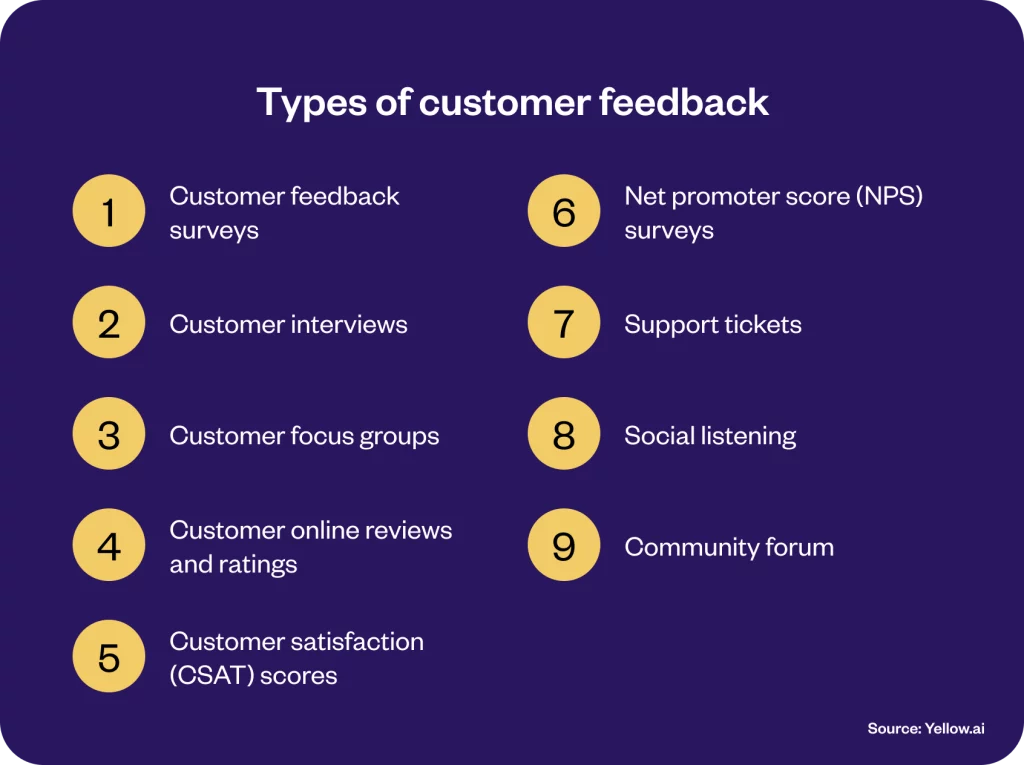
1. Customer feedback surveys
Surveys are the Swiss Army knife of feedback tools—versatile, direct, and consequential. By asking specific questions, businesses can gather quantifiable data that highlights areas of success and those needing improvement. The beauty of surveys lies in their flexibility; they can range from a single question to detailed questionnaires. For example, a well-crafted survey could reveal why a product resonates with your audience or pinpoint friction points in your service.
Utilizing surveys effectively allows businesses to make data-driven decisions. This direct line to the customer’s thoughts provides a clear roadmap for enhancements, ensuring efforts are precisely targeted to increase satisfaction and loyalty.
2. Customer interviews
Interviews offer a deep dive into the customer experience, providing a platform for detailed feedback. This face-to-face interaction is unparalleled for understanding the nuances of customer sentiment. Through thoughtful questioning, businesses can uncover not just what their customers think but why they think it.
The qualitative data garnered from interviews can illuminate your customers’ emotional journey. These insights are gold dust for creating empathetic marketing strategies and refining your product to meet customer desires better.
Related read: Customer Sentiment Analysis in 2024: How-To Guide
3. Customer focus groups
Focus groups bring together a diverse mix of customers to discuss their experiences and perceptions. This setting fosters dynamic discussions, offering a spectrum of viewpoints. Observing how customers interact with each other can also reveal unanticipated insights, making it a fertile ground for innovation.
The collaborative nature of focus groups can lead to breakthrough ideas for product development or service enhancements. They are a litmus test for gauging customer reaction to proposed changes or new offerings.
4. Customer online reviews and ratings
Online reviews and ratings are digital word-of-mouth, influencing potential customers at a critical decision-making point. They offer candid feedback on what’s working and what’s not from the customer’s perspective.
Positive reviews can bolster your brand’s reputation and drive sales, while negative feedback provides a clear indication of where improvements are necessary. Responding to reviews, both positive and negative, demonstrates a commitment to customer satisfaction.
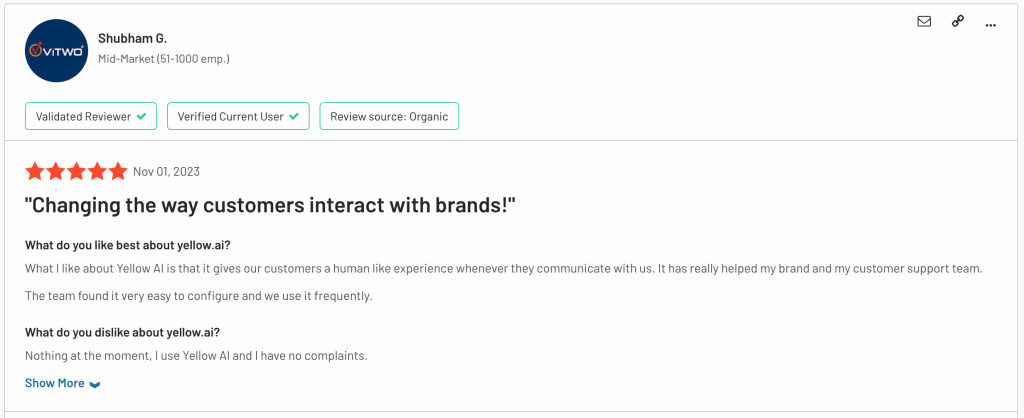
5. Customer satisfaction (CSAT) scores
CSAT scores provide a snapshot of how satisfied customers are with your product or service at a specific interaction point. This metric is straightforward to collect and offers immediate feedback on the customer’s experience.
Tracking CSAT scores over time can help identify trends in customer satisfaction, guiding strategic decisions to enhance the overall customer experience.
How to boost customer satisfaction with Yellow.ai
Yellow.ai emerges as a powerful ally for businesses seeking to boost customer satisfaction. Integrating Yellow.ai’s advanced solutions can transform your customer engagement strategy, aligning it with the modern demands of customer service. Here’s how Yellow.ai can be a game-changer for you to ace it:
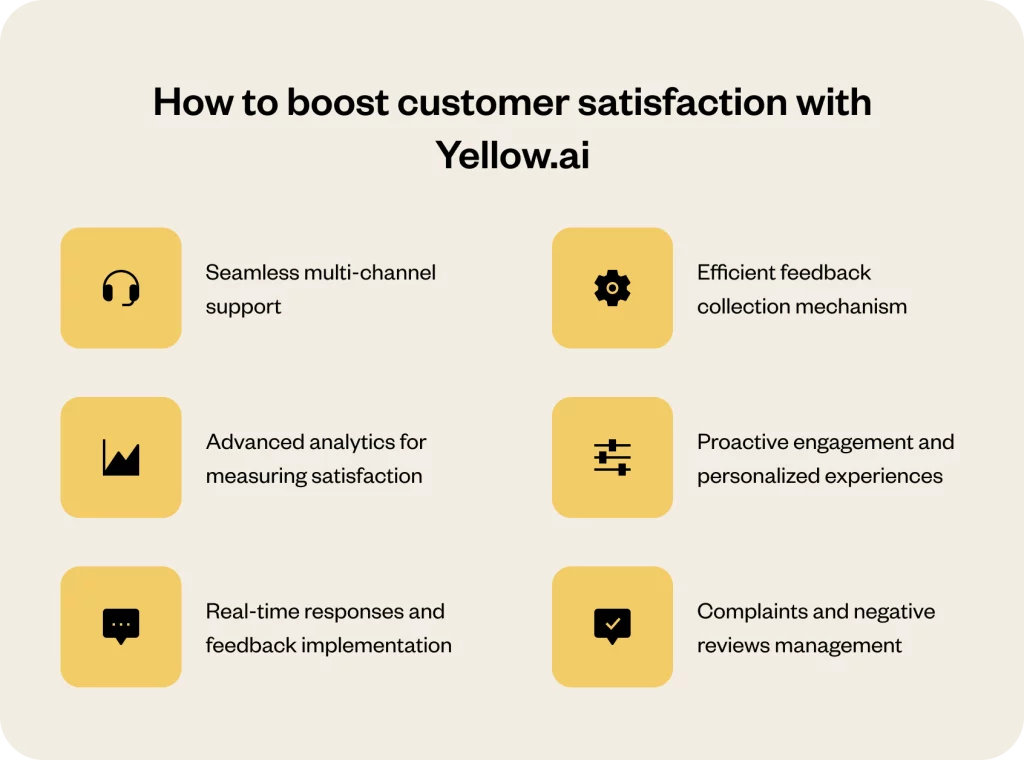
6. Net promoter score (NPS) surveys
NPS surveys measure customer loyalty by asking how likely they are to recommend your company to others. This single question can reveal your brand’s advocates and detractors, providing a precise measure of customer loyalty.
NPS helps prioritize efforts to turn passive customers into promoters and address the concerns of detractors. It directly impacts your company’s growth through customer advocacy.
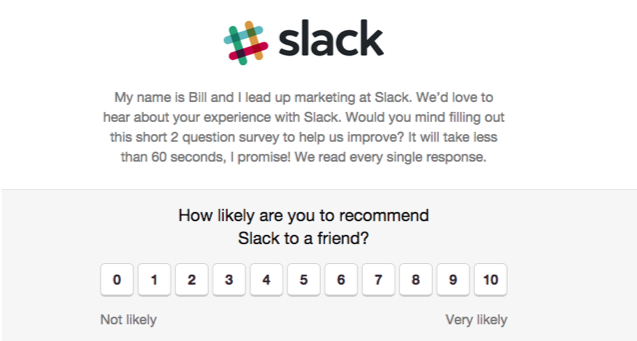
Related read: Benefits of NPS: Why use it over other customer satisfaction metrics?
7. Support tickets
Support tickets offer direct feedback on issues customers are facing. Analyzing these tickets can help identify common problems. It can guide product improvements and lead to better customer support strategies.
Efficiently resolving support tickets can turn a potentially negative experience into a positive one, improving customer retention and satisfaction.
Related read: Help desk ticketing system: Best practices for businesses
8. Social listening
Social listening involves monitoring social media for mentions of your brand, competitors, and industry. It is a real-time pulse on customer sentiment that provides unfiltered feedback on your company’s public perception.
Insights gained from social listening can inform content marketing strategies, competitive positioning, and proactive customer service, enhancing brand reputation.
9. Community forum
A community forum is a space for customers to engage with each other and your brand. It’s a rich source of feedback on user experiences, suggestions for improvements, and new features.
Leveraging community forums fosters a sense of belonging among your customers. It turns your most engaged users into brand advocates while providing a wealth of ideas for driving your business forward.
How to collect customer feedback?
Customer feedback is not just the voice of critique or praise, but it is a beacon guiding businesses toward unparalleled growth and customer satisfaction. Understanding how to collect this feedback efficiently is crucial for businesses aiming to stay attuned to their customer’s needs and preferences. Here are detailed strategies for capturing the essence of customer opinions and turning them into actionable insights.
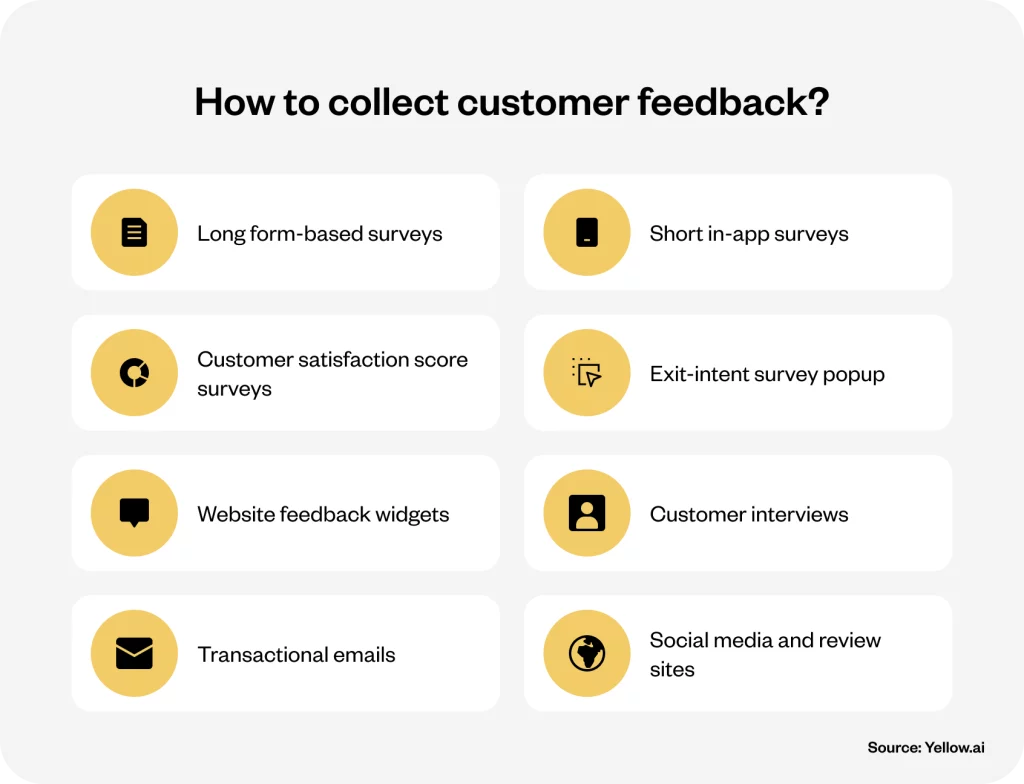
1. Long form-based surveys
Long form-based surveys consist of detailed questionnaires designed to delve deep into customer opinions, preferences, and experiences. These surveys often cover a broad range of topics that allow businesses to gather comprehensive insights on various aspects of their products or services.
The depth provided by these surveys can uncover hidden insights that may not surface in shorter formats, offering a detailed understanding of customer satisfaction, product usability, and service effectiveness. They are particularly valuable when assessing new product concepts, deep-diving into user experience issues, or understanding customer journey pain points.
To execute a long-form-based survey effectively:
- Start with a clear goal and carefully crafted questions that directly relate to that objective.
- Ensure each question adds value and avoid filler content.
- Use a mix of question types to keep the survey engaging and provide clear instructions to encourage thoughtful responses.
- Deploying the survey through targeted channels where your customers are most active will increase participation rates.
Example: A software company launches a new feature and uses a long form-based survey to understand its impact. The survey includes questions about the feature’s usability, its addition to the overall software utility, and open-ended questions for suggestions on improvements. The company then analyzes responses to refine the feature further.
When to use: Deploy long form-based surveys when you need detailed feedback on specific aspects of your product or service. They are best suited for times when you have a captive audience willing to invest time in providing feedback, such as after a significant product update, post-purchase, or as part of a customer development exercise.
2. Short in-app surveys
Short in-app surveys are concise, targeted questionnaires presented to users within a mobile app or software environment. These surveys aim to capture immediate, relevant feedback about specific features or experiences while the user is engaged with the app. They offer real-time insights that are actionable and highly relevant.
These surveys excel in capturing the pulse of the customer’s current experience, allowing businesses to identify and address issues or validate improvements quickly. The immediacy of this feedback method enhances response rates and ensures the data is reflective of the user’s actual experience.
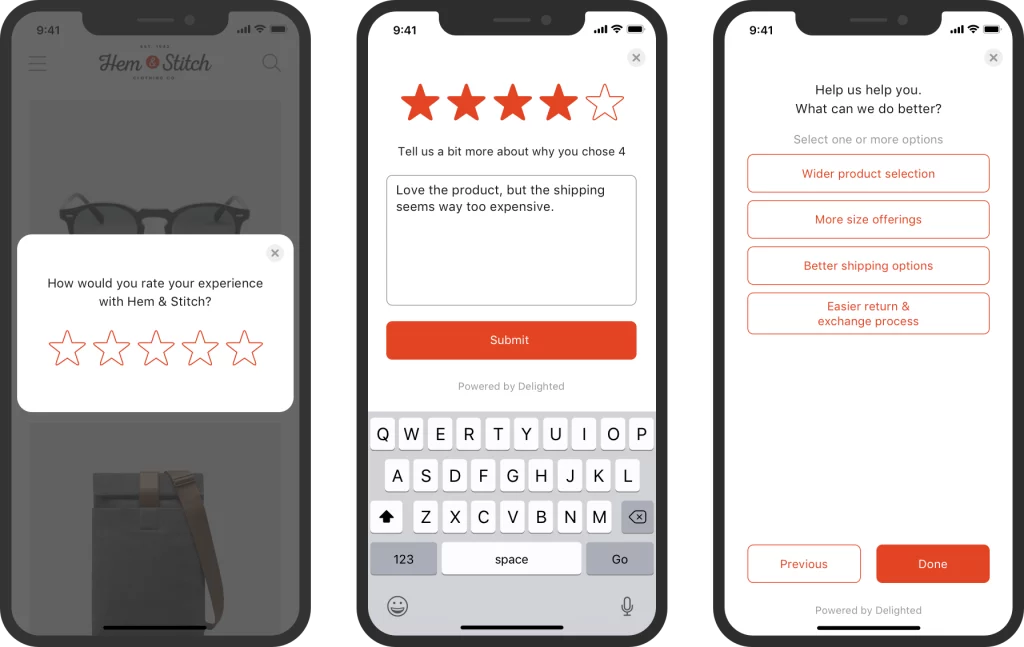
Steps to success:
- Keep in-app surveys concise and focused, limiting questions to those critical for the insight you seek.
- Timing is crucial; trigger surveys at moments that make sense within the user journey, such as after completing a task or achieving a milestone within the app.
- Customize questions based on the user’s journey stage to ensure relevance.
Example: A fitness app introduces a new workout tracking feature and deploys short in-app surveys asking users about their ease of use and satisfaction with the feature. The collected feedback helps quickly identify and address any usability issues.
When to Use: In-app surveys are ideal for gathering feedback on specific features, user interface improvements, or understanding the immediate impact of recent updates. They’re most effective when users have just interacted with your app, ensuring the feedback is grounded in fresh experiences.
3. Customer satisfaction score surveys
Customer Satisfaction Score (CSAT) Surveys measure customer satisfaction with a product, service, or specific interaction. Typically, they ask customers to rate their satisfaction on a scale. These surveys offer a quick and straightforward metric to gauge immediate customer satisfaction levels. This method provides a snapshot of how customers feel about a specific interaction, product, or service at a particular moment.
CSAT surveys allow businesses to track satisfaction trends over time and identify fluctuations in customer sentiment. This feedback is instrumental in pinpointing areas needing prompt attention and helps measure the impact of changes or improvements.
Steps to success
- Design your CSAT surveys to be short and to the point, typically asking one key question about the customer’s satisfaction level with a recent interaction or purchase.
- Follow up with an optional open-ended question for additional context.
- Ensure timely delivery post-interaction to capture the customer’s sentiment accurately.
Example: After closing a support ticket, a customer is asked to rate their satisfaction with the resolution on a scale of 1 to 5. The company tracks these scores over time to measure and improve their support team’s effectiveness.
When to use: CSAT surveys are best used immediately following customer interactions such as support calls, purchases, or service experiences. They provide quick feedback loops for operational teams to adjust and improve the customer experience continuously.
4. Exit-intent survey popup
Exit-intent survey popups engage customers at a critical moment—just as they are about to leave your website. This method offers a unique opportunity to understand what might be driving potential customers away or what changes could convert their visit into a more positive outcome.
By capturing feedback at the point of exit, businesses can gain insights into user behavior, website usability issues, or unmet needs. This feedback is invaluable for reducing bounce rates, improving website content, and optimizing the user journey.
Steps to success:
- Design your exit-intent popups to be visually appealing and non-intrusive.
- The survey should be brief, focusing on understanding the reason for the user’s departure.
- Offer an incentive when appropriate to increase completion rates.
- Use this feedback to make immediate adjustments and test changes to enhance the user experience.
Example: An ecommerce site displays an exit-intent popup survey to visitors abandoning their shopping cart, asking for reasons why they didn’t complete their purchase. Insights gained lead to changes that reduce cart abandonment rates.
When to use: Implement exit-intent survey popups on key pages of your website where you observe higher bounce rates or on pages that are critical to the customer journey. They are particularly effective on landing pages, product pages, or checkout pages, where understanding the user’s departure reason can directly influence conversions.
5. Website feedback widgets
Website feedback widgets are small, interactive tools embedded in a website that allows visitors to leave feedback directly on the site. They provide a constant, accessible channel for customers to share their thoughts and suggestions directly on your website. This method encourages ongoing dialogue with your visitors, offering insights into their needs and preferences.
Feedback collected through these widgets can lead to immediate improvements in website functionality, content relevance, and user experience. Widgets offer a low-friction way for customers to express their thoughts, enhancing customer engagement and satisfaction.
Steps to success
- Integrate feedback widgets seamlessly into your website design, ensuring they are visible without disrupting the user experience.
- Encourage users to share their feedback by making the process simple and intuitive.
- Categorize feedback to streamline analysis and action on the insights gathered.
Example: A travel blog adds a feedback widget to its articles, allowing readers to rate the usefulness of its travel guides. The blogger uses this feedback to focus on topics and destinations that readers find most valuable.
When to use: Website feedback widgets are a versatile tool suitable for continuous feedback collection across your website. They are instrumental on high-traffic pages, support sections, and product information pages where direct customer input can guide iterative improvements.
6. Customer interviews
Customer interviews are one-on-one conversations with customers to gather in-depth feedback about their experiences and perceptions. They provide an in-depth understanding of your customers’ experiences, motivations, and challenges. This qualitative feedback method allows for a nuanced exploration of customer sentiments, offering rich insights that surveys alone cannot capture.
Detailed feedback from interviews can uncover underlying customer needs, inform product development, and guide customer journey mapping. Interviews can reveal emotional drivers behind customer behavior, offering clues to enhancing customer engagement and loyalty.
Steps to success
- Prepare for customer interviews with a set of open-ended questions that encourage detailed responses.
- Choose participants representing different segments of your customer base to ensure diverse perspectives.
- Conduct interviews in a conversational tone to foster openness and honesty.
- Analyze interviews for recurring themes and actionable insights.
Example: A restaurant owner conducts customer interviews to understand diners’ experiences and expectations. Through these conversations, the owner learns about a desire for more vegetarian options and adjusts the menu accordingly.
When to use: Customer interviews are precious when exploring new market opportunities, developing new products, or when detailed feedback on specific aspects of your service is needed. They are best conducted at strategic planning stages or when considering significant changes to your offering.
7. Transactional emails
Transactional emails are automated messages sent to customers following specific actions or transactions, such as purchases or account updates. These emails present an opportune moment to solicit feedback, capitalizing on the customer’s recent interaction with your brand.
The feedback collected through transactional emails can provide immediate insights into the customer experience related to specific interactions. This method helps identify friction points in the customer journey, gauge satisfaction with recent changes, and assess the effectiveness of your communication.
Steps to success
- Incorporate a simple feedback request within your transactional emails, ensuring it is relevant to the interaction.
- Use clear, concise language, and consider including a direct link to a survey or feedback form.
- Monitor responses to identify trends and areas for improvement.
Example: After a customer makes a purchase, they receive a transactional email thanking them and asking them to rate their shopping experience. The company uses this feedback to improve its online shopping process.
When to use: Transactional emails are most effective for collecting feedback following significant customer interactions, such as after a purchase, service completion, or account modification. They provide a timely mechanism to assess satisfaction and identify opportunities for follow-up or improvement.
8. Social media and review sites
Social media platforms and review sites are public forums where customers freely share their opinions and experiences. Monitoring and engaging with feedback in these spaces allows businesses to manage their online reputation, respond to customer concerns, and showcase their commitment to customer satisfaction.
Feedback from social media and review sites can influence potential customers’ perceptions and decisions. Engaging with this feedback demonstrates a proactive approach to customer service, enhancing brand loyalty and trust. Additionally, these platforms offer insights into broader market trends and customer expectations.
Steps to success
- Implement a social listening strategy to monitor mentions of your brand, products, and related topics across social media and review sites.
- Respond promptly to feedback, acknowledging positive comments and addressing concerns or criticisms constructively.
- Use the insights gathered to inform marketing strategies, product development, and customer service improvements.
Example: A hotel monitors reviews on a popular travel review site. A negative review about room cleanliness prompts immediate action to improve housekeeping standards, and the hotel responds to the review to inform the guest of the changes.
When to use: Social media and review sites are continuous sources of customer feedback suitable for ongoing monitoring. They are precious for managing your brand’s online presence, understanding market sentiment, and engaging with customers in real time.
What to do with the feedback from customers?
Transforming customer feedback into actionable insights is pivotal for any business aiming to enhance its products, services, and overall customer experience. Here’s how businesses can effectively use the feedback they collect:
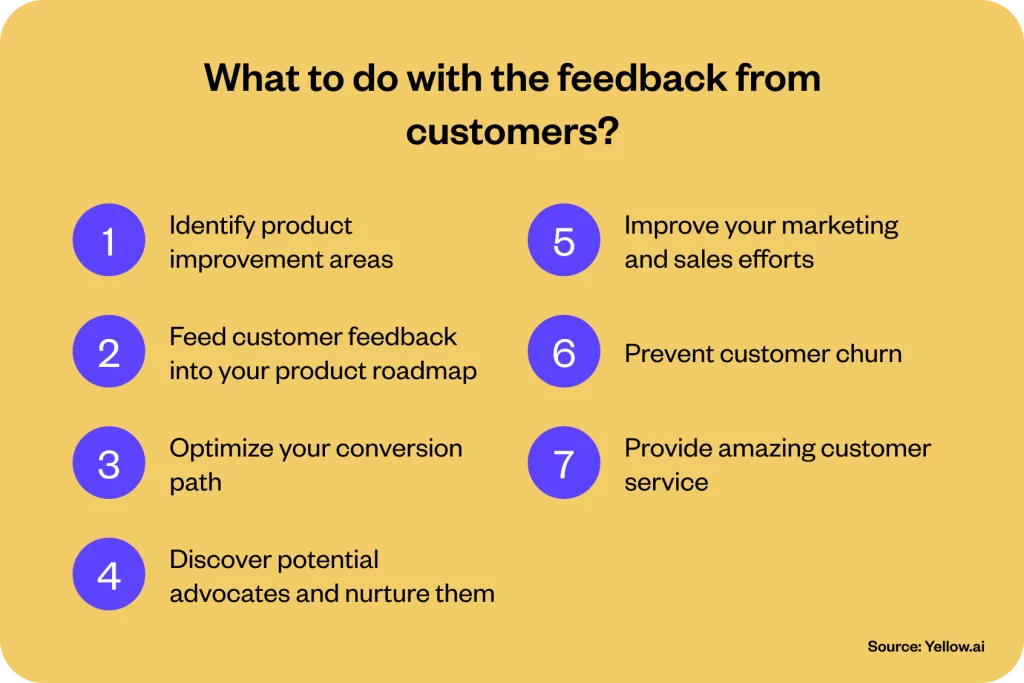
1. Identify product improvement areas
Feedback often shines a light on what customers love and what they feel could be better. By analyzing feedback, businesses can pinpoint exactly where their products or services might be falling short or where there’s room for enhancement. For instance, if multiple customers mention that a software app crashes during a specific operation, this feedback becomes a priority for the development team to fix. Identifying these areas helps in allocating resources more effectively to improve the product’s performance and customer satisfaction.
2. Feed customer feedback into your product roadmap
Integrating customer feedback into the product roadmap ensures that future developments align with customer needs and preferences. This approach helps prioritize features that hold the most value for your customers and also fosters a sense of community. That is because customers see their input making a tangible impact. For example, if a significant portion of feedback suggests the addition of a new feature, incorporating this into the roadmap can significantly boost customer engagement and loyalty.
3. Optimize your conversion path
Feedback can reveal friction points along the customer journey—from initial interest to final purchase. By understanding where potential customers drop off or experience confusion, businesses can streamline the conversion path, making it more intuitive and user-friendly. Optimizing the conversion path based on customer feedback can dramatically improve conversion rates and enhance the overall user experience.
Related read: How can customer journey maps improve customer experiences?
4. Discover potential advocates and nurture them
Positive feedback is a goldmine for identifying satisfied customers who can become brand advocates. Engaging with these customers, perhaps through loyalty programs or exclusive offers, can encourage them to share their positive experiences with others. Advocates are invaluable for organic growth, as their genuine endorsements can influence new customers in a way traditional marketing cannot.
5. Improve your marketing and sales efforts
Customer feedback provides real insights into what resonates with your audience. This information can refine marketing strategies, ensuring that messaging aligns with customer values and preferences. Tailoring marketing and sales efforts based on feedback can enhance the effectiveness of campaigns, leading to higher engagement and conversion rates.
6. Prevent customer churn
Analyzing feedback for signs of dissatisfaction or unmet needs allows businesses to proactively address issues before they lead to churn. By following up with dissatisfied customers and resolving their concerns, companies can improve customer retention. This proactive approach demonstrates to customers that their feedback is valued and that the business is committed to continuous improvement.
7. Provide amazing customer service
Feedback can inform customer service practices, enabling businesses to address common concerns more effectively and anticipate customer needs. Armed with insights from customer feedback, service teams can personalize interactions and resolve issues more swiftly, leading to higher satisfaction rates.
How Yellow.ai can help enhance customer feedback and overall customer service
Technology plays a pivotal role in shaping the future of customer service. That is where Yellow.ai steps in, redefining the landscape with its cutting-edge AI-powered solutions designed to elevate customer interactions and streamline feedback processes.
Yellow.ai’s solutions, powered by advanced Natural Language Processing (NLP), are at the forefront, enabling businesses to capture real-time customer feedback across various touchpoints. These intelligent bots can interpret and analyze feedback, regardless of the complexity or the language used, making feedback collection not just global but also insightful.
Key features of Yellow.ai
- NLP and Machine learning: Understand customer sentiments and queries with high accuracy, offering personalized responses and gathering feedback seamlessly.
- Multilingual support: Break language barriers by engaging customers in their native language, ensuring no feedback is lost in translation.
- Live chat integration: Seamlessly escalate complex queries to human agents, ensuring customers feel heard and valued at every step.
- Analytics and insights: Leverage powerful analytics to turn feedback into actionable insights, helping businesses prioritize product improvements and customer service enhancements.
Ready to revolutionize your customer feedback and service processes?

Conclusion – Collecting customer feedback is crucial
Embarking on the journey of integrating customer feedback into the heart of your business operations is more than a strategic move; it’s a commitment to excellence and continuous improvement. Yellow.ai’s innovative solutions provide not just the tools but also the vision to navigate this journey, ensuring that every piece of feedback is a stepping stone towards unmatched customer satisfaction and loyalty.
As we conclude, remember that the realm of customer feedback is ever-evolving, and staying ahead means embracing technology, innovation, and, most importantly, listening to your customers. With Yellow.ai, you’re not just adopting a platform; you’re embracing a future where every customer interaction is an opportunity to grow, innovate, and excel.
FAQs about customer feedback
What methods are most effective for collecting customer feedback today?
Today, the most effective methods for collecting customer feedback include digital surveys, AI-powered chatbots, social media monitoring, and in-app feedback tools. These methods offer real-time insights and the convenience of gathering feedback across multiple touchpoints, making it easier for businesses to understand and meet customer expectations.
What are customer feedback examples?
Customer feedback can range from product reviews, service experience ratings, satisfaction surveys, direct comments via social media, chatbot interactions, and email responses. These feedback forms provide valuable insights into customer preferences, pain points, and overall satisfaction levels.
How can we encourage more customers to provide feedback?
Encouraging customer feedback can be achieved by making the process easy and accessible, offering incentives for participation, ensuring anonymity, and communicating the importance of their input in shaping your products and services. Additionally, engaging with customers through personalized follow-ups can significantly increase feedback rates.
What role does technology play in improving feedback collection?
Technology, especially AI and machine learning, plays a crucial role in enhancing feedback collection by automating the process, analyzing large volumes of data for insights, offering multilingual support, and providing personalized customer interactions. These technological advancements enable businesses to gather and act on feedback more efficiently.
What are the best practices for analyzing customer feedback?
Best practices for analyzing customer feedback include segmenting feedback for targeted analysis, employing NLP tools to understand sentiment, prioritizing feedback based on impact, integrating feedback into actionable insights across departments, and continuously monitoring feedback trends to track improvements over time.






















